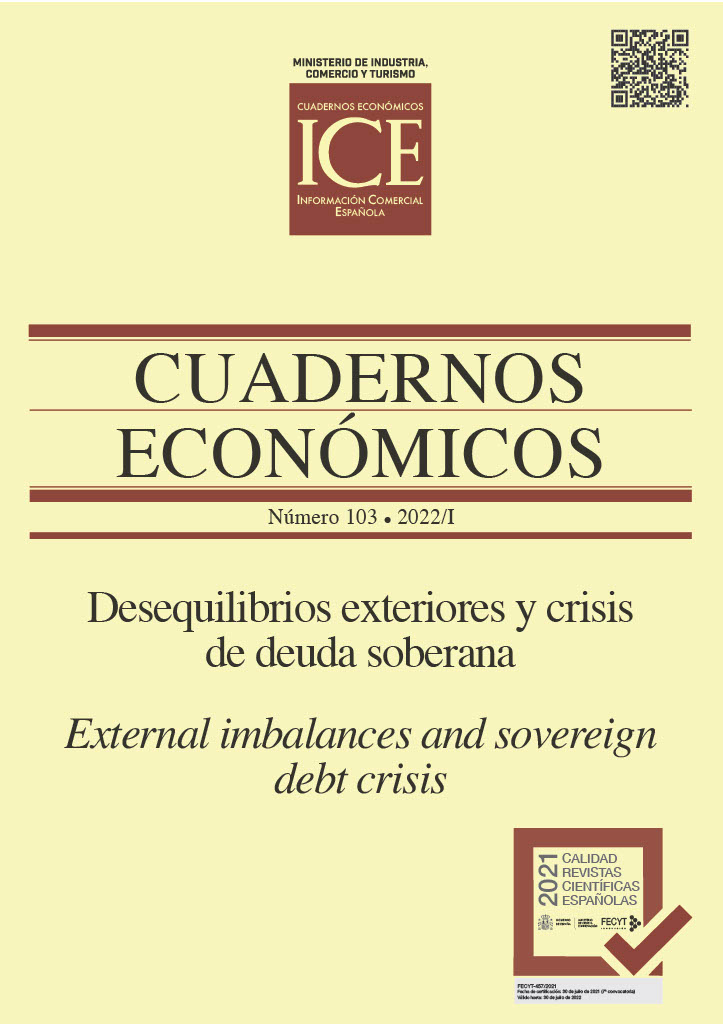Riesgo de impago y su interacción con los fundamentales: el caso de Grecia
##plugins.themes.bootstrap3.article.sidebar##
Descargas
##plugins.themes.bootstrap3.article.main##
Este artículo explica cómo implementar y calibrar un modelo de deuda con mercados incompletos, siguiendo la línea de Eaton y Gersovitz (1981) y Arellano (2008). Para mostrar cómo se puede calibrar dicho modelo, se utiliza un conjunto de datos de la economía griega como ejemplo. A lo largo del artículo, se discute el funcionamiento cuantitativo de dicho modelo, así como posibles extensiones y modificaciones que podrían llevarse a cabo en el mismo.
##plugins.themes.bootstrap3.article.details##
Adam, K. and Marcet, A. (2011). Internal rationality, imperfect market knowledge and asset prices. Journal of Economic Theory, 146(3):1224–52.
Aguiar, M. and Gopinath, G. (2006). Defaultable debt, interest rates and the current account. Journal of International Economics, 69(1):64–83.
Arellano, C. (2008). Default risk and income fluctuations in emerging economies. American Economic Review, 98(3):690–712.
Arellano, C. and Ramanarayanan, A. (2012). Default and the maturity structure in sovereign bonds. Journal of Political Economy, 120(2):187–232.
Ayres, J., Navarro, G., Nicolini, J. P., and Teles, P. (2018). Sovereign default: The role of expectations. Journal of Economic Theory, 175:803–12.
Benjamin, D. and Wright, M. L. (2009). Recovery before redemption: A theory of delays in sovereign debt renegotiations. Available at SSRN 1392539.
Bianchi, J. and Mondragon, J. (2018). Monetary independence and rollover crises (No. w25340). National Bureau of Economic Research.
Bocola, L., Bornstein, G., and Dovis, A. (2019). Quantitative sovereign default models and the european debt crisis. Journal of International Economics, 118:20– 30.
Broner, F. A., Lorenzoni, G., and Schmukler, S. L. (2013). Why do emerging economies borrow short term? Journal of the European Economic Association, 11(suppl 1):67–100.
Calvo, G. A. (1988). Servicing the public debt: The role of expectations. American Economic Review, 647-61.
Chatterjee, S. and Eyigungor, B. (2012). Maturity, indebtedness, and default risk. American Economic Review, 102(6):2674–99.
Chatterjee, S. and Eyigungor, B. (2015). A seniority arrangement for sovereign debt. American Economic Review, 105(12):3740–65.
Cole, H. L. and Kehoe, T. J. (2000). Self-fulfilling debt crises. Review of Economic Studies, 67(1):91–116.
Conesa, J. C. and Kehoe, T. J. (2017). Gambling for redemption and self–fulling debt crises. Economic Theory, 64(4):707–40.
Cruces, J. J. and Trebesch, C. (2013). Sovereign defaults: The price of haircuts. American economic Journal: macroeconomics, 5(3):85–117.
Cuadra, G. and Sapriza, H. (2006). Sovereign default, terms of trade, and interest rates in emerging markets.
Dias, D. A., Richmond, C., and Wright, M. L. (2014). The stock of external sovereign debt: Can we take the data at ‘face value’? Journal of International Economics, 94(1):1–17.
Eaton, J. and Gersovitz, M. (1981). Debt with potential repudiation: Theoretical and empirical analysis. Review of Economic Studies, 48(2):289–309.
Fernández-Villaverde, J., Guerrón-Quintana, P., Rubio-Ramirez, J. F., and Uribe, M. (2011). Risk matters: The real effects of volatility shocks. American Economic Review, 101(6):2530–61.
Guimaraes, B. (2011). Sovereign default: which shocks matter? Review of Economic Dynamics, 14(4):553–76.
Hamann, F. (2002). Sovereign risk and macroeconomic fluctuations. Borradores de Econom´?a, 225.
Hamilton, J. D. (2018). Why you should never use the Hodrick-Prescott filter.
Review of Economics and Statistics, 100(5):831–43.
Hatchondo, J. C. and Martinez, L. (2010). The politics of sovereign defaults. FRB Richmond Economic Quarterly, 96(3):291–317.
Hatchondo, J. C., Martinez, L., and Sapriza, H. (2010). Quantitative properties of sovereign default models: solution methods matter. Review of Economic dynamics, 13(4):919–33.
Hatchondo, J. C., Martinez, L., and Sosa-Padilla, C. (2016). Debt dilution and sovereign default risk. Journal of Political Economy, 124(5):1383–1422.
Johri, A., Khan, S., and Sosa-Padilla, C. (2020). Interest rate uncertainty and sovereign default risk (No. w27639). National Bureau of Economic Research.
Lorenzoni, G. and Werning, I. (2019). Slow moving debt crises. American Economic Review, 109(9):3229–63.
Paluszynski, R. (2017). Learning about debt crises. manuscript, University of Hous- ton.
Schmitt-Groh´e, S. and Uribe, M. (2009). Finite-state approximation of var processes: a simulation approach. Columbia University.
Tomz, M. and Wright, M. L. (2007). Do countries default in “bad times”? Journal of the European Economic Association, 5(2-3):352–60.
Uribe, M. and Yue, V. Z. (2006). Country spreads and emerging countries: Who drives whom? Journal of International Economics, 69(1):6–36.
Yue, V. Z. (2010). Sovereign default and debt renegotiation. Journal of international Economics, 80(2):176–87.


